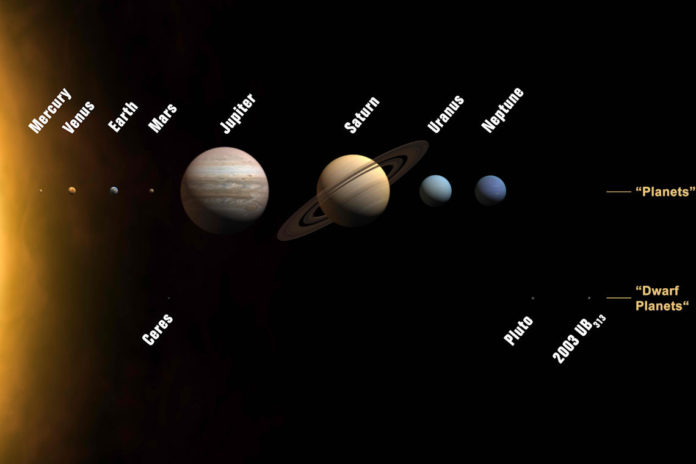The solar system is a star system. It is just one of many other star systems that make up the Milky Way galaxy. A star system is made up of a star and the planets that orbit it.
Our solar system is made up of a star (Sol – the sun) and eight main planets. In addition, there are several dwarf planets that orbit the sun. Planet Earth is the third main planet the sun.
Birth of the Solar System
How was the solar system created?
Nebula: In the beginning, the universe was made up of huge clouds of gas and dust. One of these clouds is known as a nebula. As time passed, gravity began to pull the gas and dust particles into larger clumps. Gravity is a force of attraction that all objects have. The large clumps had even more gravity to attract even more material an these clumps grew larger and larger.
Stars: About 4.6 billion years ago, the nebula cloud began to collapse into balls of dust and gas. Gravitational pull caused these balls to shrink and spin. This created heat and when temperatures were high enough, these balls began to turn into stars.
Planets: Most of the gas and dust collapsed into a star. However, a small amount of gas and dust formed into a disc circling each star. Again, gravity created small balls of gas and dust within this disc. In time, these smaller balls collapsed into planets.
The Sun
Sol is the star located at the center of our solar system. It is made up of hydrogen and helium. Today, it continues to generate heat and light through nuclear fusion. Fusion creates energy when two hydrogen atoms are merged into helium. The sun is considered a middle-aged yellow dwarf star.
The sun is the primary source of energy for life on earth. It is also the energy source energy that drives the Earth’s atmosphere and ocean currents.
The Planets in the Solar System
A planet is an object that orbits the sun. It has enough mass and gravitational pull to have a round shape. In addition, a planet has absorbed most of the smaller objects within its orbit around the sun.
There are eight main planets in the solar system. The four inner planets are rocky terrestrial planets. The four outer planets are gas or ice giants.
Terrestrial Planets: Mercury, Venus, Earth, and Mars are terrestrial planets. These planets are located closest to the sun. They have a rocky composition and are very dense. In general, these planets have a solid surface and few moons.
Giant Planets: Jupiter, Saturn, Neptune, and Uranus are giant planets. They are located furthest from the sun. Some are ice giants that are made up of hydrogen and helium gas and lack a solid surface. Although they are giant planets, their gaseous nature give them low densities. The gas giants have many moons and sometimes they have planetary rings. Jupiter and Saturn are gas giants.
Uranus and Neptune are ice planets. The ice is made up of many different gases.
Dwarf Planets: Dwarf “planets” are too small to be considered a planet. Pluto and Ceres are the most well known dwarf planets. At one time, Pluto was classified as a planet.
Reflections
Vocabulary
- gravity
- planet
- solar system
Notes
- The solar system is a star system with a central star and orbiting planets.
- Gravity is the primary force that created the solar system.
- The sun has an inner belt of terrestrial planets and an outer belt of gas and ice giants.

